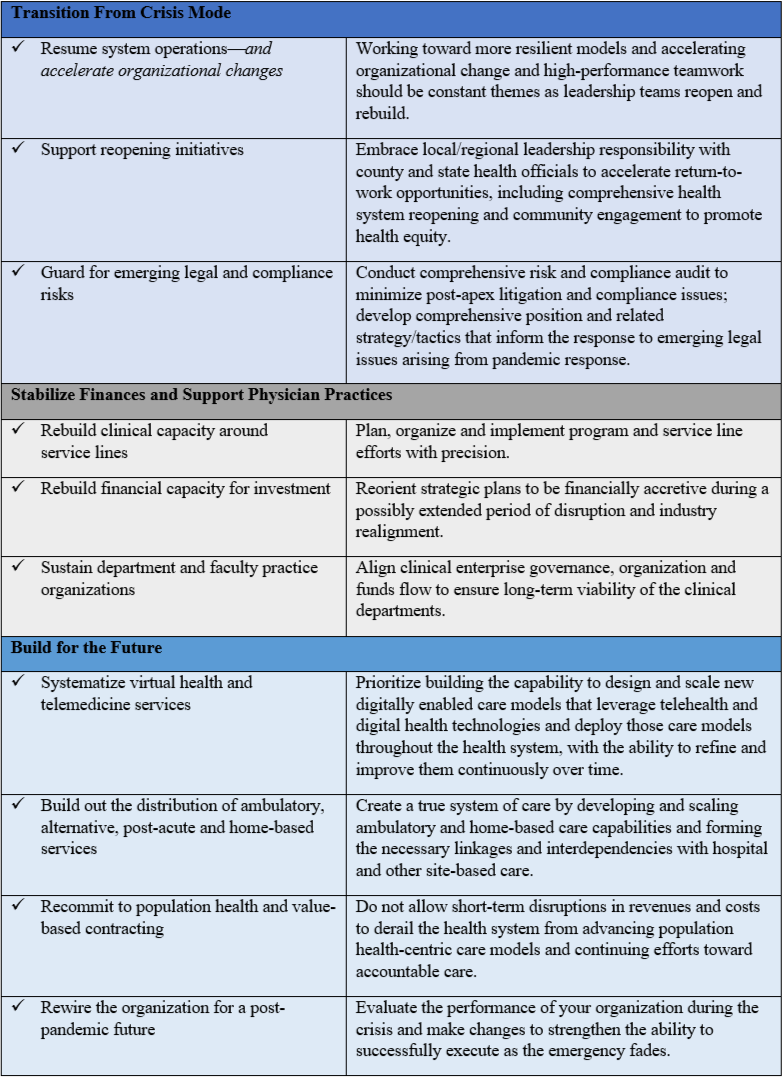Emergence From COVID-19: Imperatives for Health System Leaders
Editor’s Note: The COVID-19 crisis has brought great adversity, and our health systems and academic centers are responding with innovation. Policymakers have rapidly lifted myriad barriers to providing care in novel ways, and health systems have quickly scaled up virtual care, hospital-at-home programs and home-based care. Telehealth video and phone visits have ballooned from the tens or hundreds to many thousands per day at major institutions, prompting rapid acceleration in digital patient engagement. Health systems with population health capabilities have used them to manage patients through the crisis. Those with health plans have benefited from the financial diversification. And those with well-developed post-acute programs have helped patients successfully navigate the transitions among hospitals, skilled nursing facilities and their homes.
In a new briefing, summarized below, Manatt Health examines the challenges health system leaders are facing throughout the pandemic; imperatives for moving forward; and actionable recommendations for transitioning out of the crisis mode, stabilizing finances, supporting clinician practices and building for the future. The briefing also shares critical issues and key questions that health system leaders must address in developing strategies to advance a more resilient healthcare system. Click here to download a free copy of the full white paper.
Challenges, Changes and Imperatives for Health System Leaders
The pandemic has driven a vast range of significant and complex challenges, including:
- Disrupting care delivery options,
- Stressing workforces in hot spots to the breaking point,
- Decimating healthcare finances and balance sheets,
- Shifting the payer mix,
- Exacerbating health equity and social justice issues, and
- Increasing consumer anxiety to the point that fear overrides the need for health services.
During the crisis, in response to this growing array of issues, health systems have begun to make important changes to their typically unwieldy organizational structures. Operational and policy decisions have been made quickly and nimbly. Coordination and communication processes have been vastly enhanced under the pressure of immediate needs. The priorities of recent weeks have been protecting health workers, acquiring personal protective equipment (PPE) and special supplies, ramping up telehealth, establishing COVID-19 units, managing clinic closures and reopenings, and a myriad of other complex undertakings.
Every health system leadership team should challenge itself to self-assess its performance. How did we do? What could we have done better? Are we working effectively with our community on deep health equity and social justice issues? What changes in how we work should we keep—and accelerate? Emergence from the crisis offers the leaders of health systems and academic centers a profound opportunity to reflect on how to remake their institutions to be stronger, more effective, more engaged and more resilient organizations.1
The immediate imperatives are to safely resume elective clinical services, stabilize finances and support physician practices to get back to a semblance of normal operations. This work must occur while simultaneously continuing to manage COVID-19 cases, preparing for subsequent infection waves, engaging with the community to prevent further spread and preparing the organization for future unknowns.
Clearly communicating the “new” experience that can be expected in accessing healthcare facilities for services is essential to alleviate patient anxieties and rebuild patient volumes. More fundamentally, the success of a post-COVID-19 strategy will be measured on whether the health system is positioned as a leader for positive change within the community, and early steps to support safe reopening will be instrumental in achieving this objective.
A next priority is shoring up tertiary and quaternary services, where academic health centers and large health systems have a natural advantage and that provide the margins that sustain academic and community missions. Service excellence and clinical integration will be essential ingredients. The collapse in current-year finances and the dismal forecast for future margins will require rebuilding financial capacity for investment and focusing near-term attention on realizing operational efficiencies, cost reductions and workflow realignments to facilitate throughput.
Longer term, the focus will be on building the next-generation system of care to be extensively digital, highly interconnected, broadly distributed, deeply engaged with the community—and the linchpin of a resilient health system. This ambitious agenda will require rewiring the organizational structure to align with the new priorities, emerging demands and need for greater resilience in the face of future black swan events.
Recommendations for Health System Leaders

Note: To download a free copy of the full playbook, click here.
1 See the articulation of this point of view in “How Academic Health Systems Can Move Forward Once COVID-19 Wanes.” Steven D. Shapiro, M.D.; Paul B. Rothman. JAMA. Published online May 20, 2020. https://jamanetwork.com/journals/jama/fullarticle/2766527.
